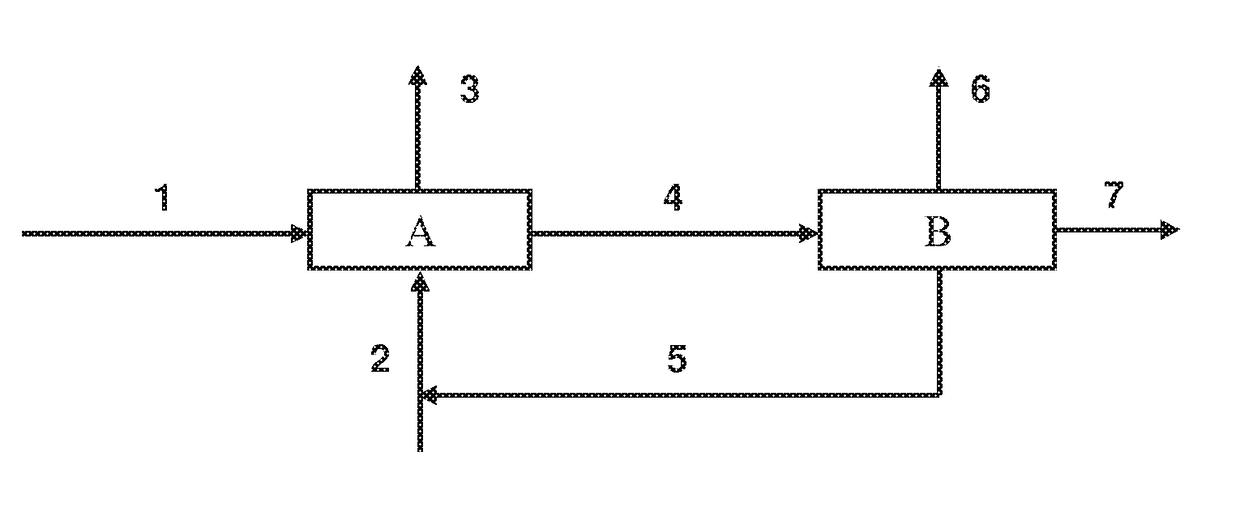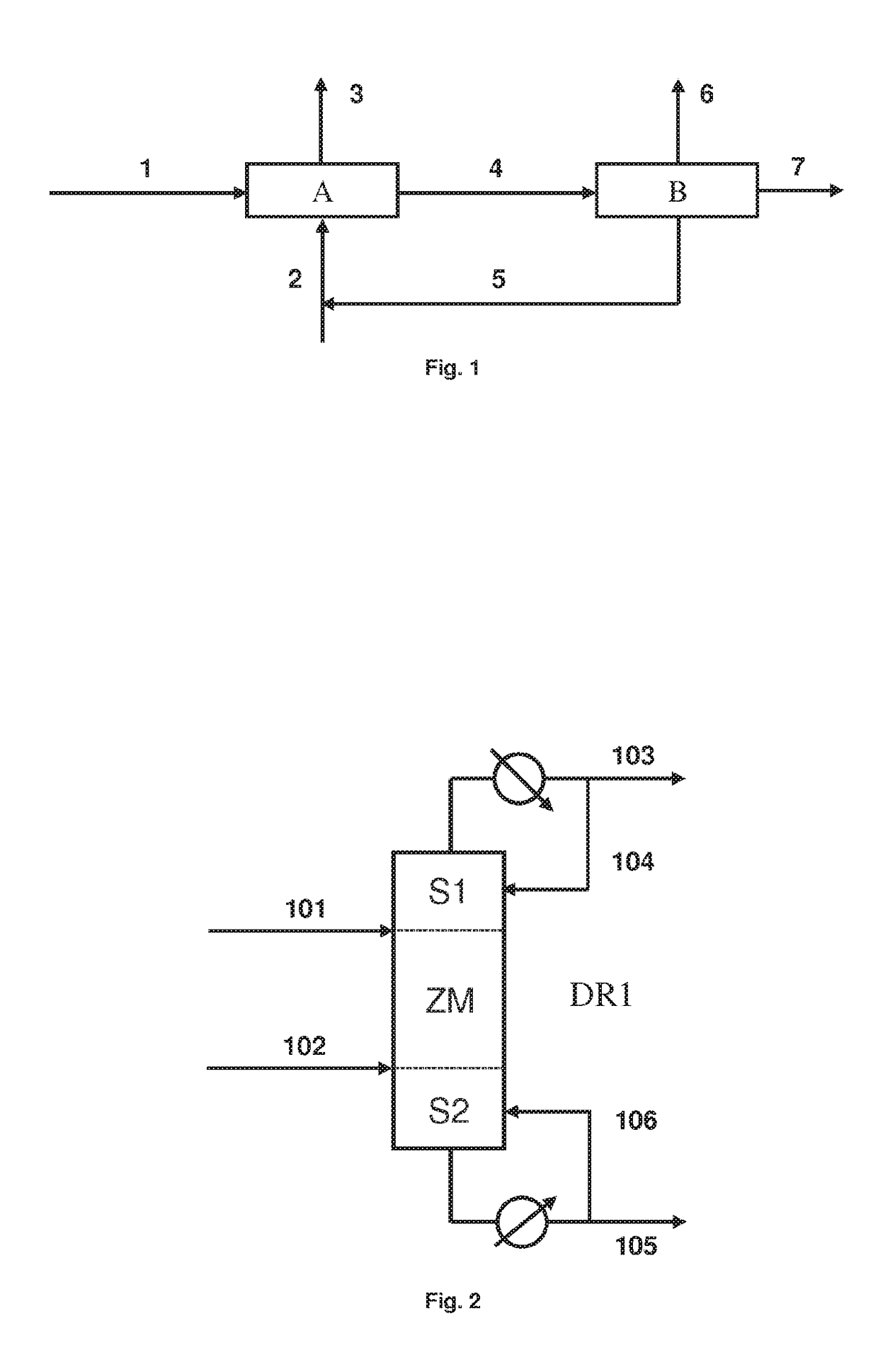Method for esterification of a diol using a reactive distillation
- Summary
- Abstract
- Description
- Claims
- Application Information
AI Technical Summary
Benefits of technology
Problems solved by technology
Method used
Image
Examples
example 1
Esterification Implemented by Reactive Distillation (For Comparison)
[0071]This example shows the performances of a method for esterification by reactive distillation implemented according to the teaching of the prior art.
[0072]The esterification of 2,3-butanediol (2,3-BDO) by acetic acid is catalyzed by sulfuric acid. This esterification is implemented in a reactive distillation under the operating conditions described in “Continuous Process for Acetylation of 2,3-Butylene Glycol,” Industrial and Engineering Chemistry, 1945, Vol. 37, No. 9, pp. 872-877.
[0073]The reactive distillation column comprises 13 plates numbered from top to bottom. 50.46 kmol / h of feedstock at 110° C., comprising 2,3-BDO and 1% by mass of sulfuric acid in relation to 2,3-BDO, is introduced in the area of the plate 3. 300 kmol / h of acetic acid at 110° C. is injected at the bottom of the column (plate 13). The distillate reflux is reinjected at plate 1, with a molar reflux rate of 1, and the residue reflux is r...
example 2
Esterification Implemented by Reactive Distillation (Invention)
[0083]This example shows the performances of a method for esterification by reactive distillation implemented according to the invention.
[0084]The reactive distillation column comprises 20 plates numbered from top to bottom. 50 kmol / h of feedstock, consisting of 2,3-BDO at 110° C., is introduced in the area of the plate 5. 150 kmol / h of acetic acid at 110° C. is injected in the area of the plate 15. The distillate reflux is reinjected at plate 1, with a molar reflux rate of 1, and the residue reflux is reinjected at plate 20, with a molar reboil rate of 5.3.
[0085]The column is operated with a pressure and a temperature at the top of 0.1 MPa and 90.9° C., and a pressure and a temperature at the bottom of 0.11 MPa and 206.3° C.
[0086]The dwell time in the column is 2 hours. The dwell time per reactive plate is 24 minutes. The column comprises 5 reactive plates containing an ion-exchange acid resin (Dry Amberlyst 35), with t...
example 3
Recycling of the Liquid Pyrolysis Effluent
[0092]This example shows the possibility of recycling the liquid pyrolysis effluent according to the invention.
[0093]The residue of Example 2 feeds a pyrolysis step, which comprises a pyrolysis furnace operated at 580° C. with a contact time of approximately 2 s. The pyrolysis effluent is quickly cooled to 45° C. and condenses into a liquid pyrolysis effluent. The uncondensed part, which constitutes the vapor pyrolysis effluent, comprises 97.5% by weight of 1,3-butadiene. The composition of the liquid pyrolysis effluent is indicated in Table 1.
TABLE 1Composition by Mass and Molar Compositionof the Liquid Pyrolysis Effluent.% by MassMol %AA79.60%83.54%2,3-BDOdiAc2.81%1.02%BDE9.01%10.51%VCH0.62%0.36%MEK0.57%0.50%MVCA0.95%0.52%MEKEA3.49%1.93%CA2.64%1.46%MAA0.31%0.17%2,3-BDODiAc = 2,3-Butanediol Diacetate, BDE = Butadiene, VCH = Vinyl Cyclohexene, MEK = Methyl Ethyl Ketone, MAA = Methylacetylacetone, MVCA = Methyl Vinyl Carbinol Acetate, MEKEA =...
PUM
| Property | Measurement | Unit |
|---|---|---|
| Temperature | aaaaa | aaaaa |
| Temperature | aaaaa | aaaaa |
| Temperature | aaaaa | aaaaa |
Abstract
Description
Claims
Application Information
 Login to View More
Login to View More - R&D
- Intellectual Property
- Life Sciences
- Materials
- Tech Scout
- Unparalleled Data Quality
- Higher Quality Content
- 60% Fewer Hallucinations
Browse by: Latest US Patents, China's latest patents, Technical Efficacy Thesaurus, Application Domain, Technology Topic, Popular Technical Reports.
© 2025 PatSnap. All rights reserved.Legal|Privacy policy|Modern Slavery Act Transparency Statement|Sitemap|About US| Contact US: help@patsnap.com



